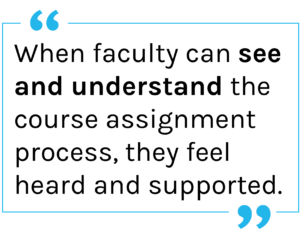In HigherEd, faculty retention and student retention are closely linked.

Retaining faculty is critical to maintaining a high-quality education and a positive learning environment for students. When faculty members leave, students may feel less connected to their university, leading to decreased student retention rates.
Faculty are the most direct link to students on campus and have the most direct impact on whether or not they graduate—they are mentors, role models, and help students navigate academic challenges and sometimes offer career advice.
Maintaining an engaged faculty is vital to keep students enrolled– so how do you make sure that faculty stay? Below, we’ll explore a few retention techniques for HigherEd campuses to improve faculty retention.
Campus culture
Creating a campus-wide culture of faculty support can go a long way towards combatting burnout, which remains a challenge for most institutions today. It’s important to provide support services and opportunities for connection (both for on-campus faculty and any virtual/online instructors) so that faculty feel supported, listened to, and valued. If they feel overwhelmed and undervalued, they’re more likely to look outside the institution for opportunities. In the past few years, record numbers of faculty have left academic work and also stepped back from their roles in other ways to combat stress.
Digitization
One key to stopping the trend of overworked faculty is ensuring that academic affairs teams have full insight into faculty workload. That workload is complex and sometimes underestimated, because things like research and service aren’t taken into account when scheduling courses for a semester.
You can take a big step towards positive relationships with your faculty by investing in a digitized, transparent Teaching Assignment Management System, which not only gives faculty the ability to easily submit course preferences, but also allows administrators to choose the best instructor for each course depending on their teaching history and holistic workload.
When faculty can see and understand the assignment process, they feel heard and supported—and when administrators can see the full faculty workload, they can make sure no one is overburdened.
faculty workload, they can make sure no one is overburdened.
Professional development
The path to promotion and tenure for faculty can sometimes be unclear. When the requirements for tenure are vague, or when the opportunity to move into a leadership or administrative position seems to be offered randomly, faculty can be discouraged from continuing to push forward. This is especially true for women and minority faculty members, who face a leaky pipeline – they don’t make it into tenured and leadership positions on most campuses as easily.
Digitization is again the starting point here: start tracking and examining your faculty data throughout the tenure process, comparing different departments or colleges to see if there are places where—for instance—women are achieving tenure at a lower rate than men. Transparency is the first step to tackling the problem!
Final thoughts
Faculty retention and student retention are deeply interconnected—and if your institution is focused on student retention, you must also take steps to improve faculty retention. To learn more about supporting faculty through a digitized faculty ecosystem, reach out to PeopleAdmin’s experts today.